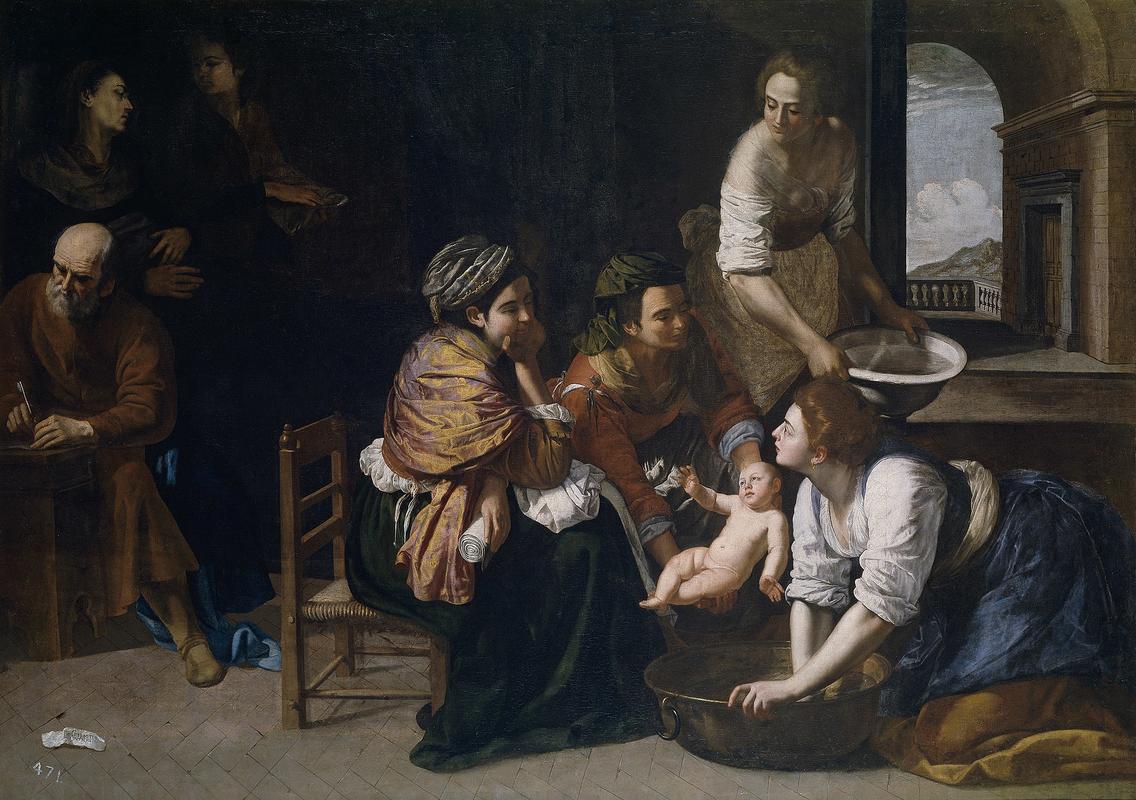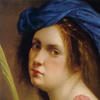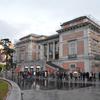More about The Birth of Saint John the Baptist

Contributor
Artemisia Gentileschi’s Nativity of Saint John the Baptist celebrates the first few breaths of Saint John’s life.
In the beginning there was Zacharias and Elizabeth, and an angel, Gabriel. After being told they would have a child, falling pregnant at such an elderly age seemed impossible to Zacharias. Big mistake. Never doubt an angel. Consequently, Zacharias was struck deaf and mute until his child’s birth. Tough punishment for the nonbelievers, but when an angel comes to you with information, maybe it’s a good idea not to doubt it.
Gabriel even named the child: John. (The Baptist came later. Right now, he’s simply John.) And yet no one in the family had the name John. The midwives thought, “Which John are Elizabeth and Zacharias naming their child after?” These ladies believed it better to name the child after his father, the deaf and mute one sitting with the tablet. However, playing it smart by remaining true to the Holy spirit, and possibly his fear of Gabriel, Zacharias etched the name ‘John’ on a tablet. Once John was born, Zacharias could speak to his baby, and even hear the damn crying in the early hours of the morning. Hoo-rah, I say sarcastically.
These are the conditions to being a disciple of God. One, don’t doubt the angel who relayed the information. Two, name him whatever the angel intends. And three, absolutely, under no circumstances, will the child drink liquor, and yes that includes sneaky wine with dinner. It’s a hard life, but being in the good graces of God will take you a long way.
John the Baptist was the man announcing Jesus’s coming. He was the cousin of God’s son, and even baptized him. John was the man preaching to the citizens to repent for their sins in preparation of the lord’s arrival. In the end, John was beheaded by King Herod on August 29th. That’s what you get for calling the king out for adultery.
Being a favorite of the king can get you places, as Artemisia knows best. Nativity of St. John the Baptist was a royal commission. The King of Spain, Philip IV, commissioned the painting apparently for a chapel dedicated to Saint John. Artemisia had help securing the commission from Cassiano dal Pozzo. The Naples court was tolerant of female artists. Unlike some of their contemporaries, the Neapolitan court did not chuck a hissy-fit. They commissioned artists based on talent, not gender. Artemisia Gentileschi attained the John the Baptist commission based on her renowned skill.
The painting was speedily completed “at a breakneck pace,” says art historian Raymond Ward Bissell. Speedy, perhaps because it’s believed Gentileschi was uncomfortable with the religious subject. So why take on the painting? Apparently Gentileschi was strapped for cash. Don’t get her wrong, Gentileschi had many commissions. And yet, money was tight.
Sources
- Angelus Staff, “The Passion of St. John the Baptist,” Angelus, August 29, 2019. Accessed September 11, 2019. https://angelusnews.com/news/angelus-staff/the-passion-of-st-john-the-b…
- Christiansen, Keith, Mann, Judith W., Orazio and Artemisia Gentileschi. New Haven: Yale University Press, 2001.
- Crossan, John D., “John the Baptist,” PBS, April 1998. Accessed September 11, 2019. https://www.pbs.org/wgbh/pages/frontline/shows/religion/portrait/john.h…
- Russell, Peter, Delphi Complete Works of Artemisia Gentileschi (Illustrated). Delphi Classics, 2017.
- GCT, “Feast Day of Holy Prophet Zachariah and Righteous Elizabeth,” Greek City Times. Accessed September 11, 2019. https://greekcitytimes.com/2019/09/05/feast-day-holy-prophet-zachariah-…
- Isbouts, Jean-Pierre, “The Birth of John the Baptist was a Miracle. Here’s Why.,” National Geographic, February 22, 2019. Accessed September 11, 2019. https://www.nationalgeographic.com/culture/people-in-the-bible/john-bap…
- Locker, Jesse, Artemisia Gentileschi: The Language of Painting, New Haven: Yale University Press.
- Marks, Thomas, “The Prado Pulls out the stops for its 200th Birthday,” Apollo Magazine, April 22, 2019. Accessed September 1, 2019. https://www.apollo-magazine.com/museo-nacional-del-prado-200/
- Marrin, Pat, “The Passion of John the Baptist,” National Catholic Reporter, August 28, 2019. Accessed September 11, 2019. https://www.ncronline.org/news/spirituality/pencil-preaching/passion-jo…
- Than, Ker, “John the Baptist’s Bones Found?” National Geographic, June 18, 2012. Accessed September 11, 2019. https://www.nationalgeographic.com/news/2012/6/120618-john-the-baptist-…
Featured Content
Here is what Wikipedia says about The Birth of Saint John the Baptist (Artemisia Gentileschi)
The Birth of Saint John the Baptist, by Artemisia Gentileschi, was part of a six-painting portrayal of Saint John's life, with four of the paintings by Massimo Stanzione and one (now lost) by Paolo Finoglia, for the Hermitage of San Juan Bautista (Saint John the Baptist) on the grounds of Buen Rierto in Madrid, under orders from the Viceroy of Naples, the Conde de Monterrey. Although a date has not been agreed upon by scholars, Artemesia most likely painted The Birth of Saint John the Baptist between 1633 and 1635. It is one of the most renowned works from Artemisia's Naples period, especially due to its detailed rendering of fabrics and floor tiles.
The painting depicts a Bible story from Luke 1:5-80, in which Zacharias and his wife, Elizabeth, are too old to have children. One day the angel Gabriel appears to tell Zacharias that he and Elizabeth will have a son named John. Zacharias is literally dumbfounded and loses his ability to speak. Later, the baby is born and all the couple's neighbors and midwives insist that the baby should be named Zacharias, after his father. Elizabeth disagrees, so they ask for Zacharias's opinion. He writes on a tablet “His name is John” and regains his ability to speak. Thus Saint John the Baptist begins his miraculous life.
Before moving to Naples, Artemisia was known for arguably pre-feminist, secular works; but in Naples she began painting a great number of commissions for Spanish rulers and churches, so her subject matter became more religious. The composition of this painting, which emphasizes female neighbors and maidservants rather than the miracle of the story, is distinctly secular. The style of this painting, though specific to Artemisia, is heavily influenced by Caravaggio, Simon Vouet, and Massimo Stanzione. The painting is now on display at the Prado Museum in Madrid.
Check out the full Wikipedia article about The Birth of Saint John the Baptist (Artemisia Gentileschi)












